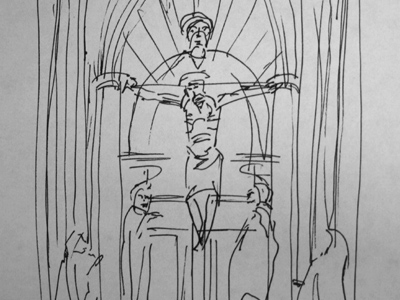"the
history of harmony has followed the series of natural overtones" -Cowell,
source : from unisons and fifths, through
the realignment of harmony to thirds, and increasing dissoance, to order
and chaos : the history of harmony was mapped in advance by pythagoras who
observed that the further from the fundamental the more dissonant the interval .
and
so the history of harmony progressed according to pythagoras' map: unison,
perfect octave, perfect fifth, perfect fourth, major third, minor third,
major second, minor second, : demoiselles d'avignon : the world was completely
changed and Schönberg made pierrot : and he visited traunkirchen on
traunsee and observed that 'time for a change had arrived' : the intermezzo .
"The
Crucifixion and the Death are rejection and affirmation at once, for they
affirm death only to reject death; the intensity of that death is the opportunity
of its own dissolution; ..." — Charles Williams

these thoughts are dreams : dreams are ends in themselves .
"The
long silence, the vast silence, of the forest had only three sounds—the
voices of the two poets and the sound of Dante's feet. Now 'the secret things—segrete
cose' begin to sound. Silence is broken. As they pass the arch, they come
into an air 'senza tempo tinto—tinted without time', dark and unchanging."
— Charles Williams .
process, it is the part of something that
determines its quality but is not physically evident, it "...
comes into being, like any other natural factor, in order to flourish and
disappear, not to leave traces in mechanical ritual, or anthropologically
interesting survivals. The function of a nutrient is to become transmuted,
not to leave unaltered traces." — Idries Shah. elusiveness is therefore its currency .
when the temporal dimension is collapsed, the process and the
goal are given a new relationship, they are simultaneous . the elimination of the temporal dimension allows the
process to become equivalent in stature to the end result : senza tempo
tinto .
'like words, ... images in a poem tend to fall into overtone
themes united by either their denotations or connotations.' —
Ciardi : 'All metaphor is basically
a way of speaking of the unkown in terms of the known. The metaphoric formula
may thus be stated: X (unkown) = Y (known) ... [The poet's] contract is
simple: if the reader will bring a fluent and supple mind to play upon the
Y of the metaphor, the poet will engage to give him an experience of the
X. But he will also undertake to give him an experience of the pleasurable
interplay of X upon Y' .
Charles
Williams paraphrases Coleridge: 'Coleridge said that a symbol must
have three characteristics (i) it must exist in itself, (ii) it must derive
from something greater than itself, (iii) it must represent in itself
that greatness from which it derives. I have preferred the word image
to the word symbol because it seems to me doubtful if the word symbol
nowadays sufficiently expresses the vivid individual existence of the
lesser thing.': Ciardi:, 'The distinction
between a symbol and a metaphor can not be rigidly drawn, but a symbol
tends to stand for a more formal and more expansive area of meaning or
of experience ... whereas a metaphor tends to be more specific and rather
more sensory than conceptual. What is basic to both is the metaphoric
sense. Nothing is more characteristic of poetry than this metaphoric sense.' : Kenneth Clark: 'High Gothic art can look fantastic and luxurious ... Medieval
man could see things very clearly, but he believed that these appearances
should be considered as nothing more than symbols or tokens of an ideal
order, which was the only true reality.' .
Borges: 'In the sixth chapter of the first part, the priest and the barber inspect Don Quixote's library; astoundingly, one of the books examined is Cervantes' own Galatea ...' And Borges tells that 'The barber, a dream or the form of a dream of Cervantes, passes judgement on Cervantes' .
unfinished
michaelangelos,
to see them is to see the raw print of the chisel in the marble, the only
thing left for us to be excited about : the process itself